The Bay Trail Preview: Intel Atom Z3770 Tested
by Anand Lal Shimpi & Brian Klug on September 11, 2013 12:00 PM ESTIn addition to showing Bay Trail running on a Windows 8.x platform, Intel showed us a “pre-beta” version of the platform running Android 4.2.2. I have to emphasize that the build they showed us definitely seemed pre-beta, as there was some instability, but overall the build was good enough to run some tests on and get a feel for. Intel made it clear that they do have a lot more work to do on their Android build before it’s considered close to final quality than the Windows equivalent.
Inside Android we can still see the CPU state table data and how long the cores are sitting in each performance state still, despite this now being managed in-silicon on Bay Trail. In addition Android sees the 2.39 GHz Z3770 boost frequency and reports it. I didn’t see any strange behavior on the device while running tests and watching CPU frequency, if anything the reference design platform stayed at the maximum boost frequency even with four cores plugged in for an impressive amount of time. Of course this is a tablet so there’s more TDP to play around with compared to a phone.
Depending on where you were in the Android UI, there was some definite stutter, but I’m told this is a result of an issue with Dalvik not allocating threads to cores properly that Intel is still tuning, something which you can see plays itself out as well in the AndEBench Java test that runs in Dalvik. The launcher especially had some stutter, but Intel claimed they were aware of it and that final performance in areas like that would be dramatically improved. Regardless of the state of Bay Trail’s Android port, it affords us the opportunity to look at performance through our pretty standard benchmark suite.
On the CPU side for Android we’re still limited to just a few tests that rely on a combination of native code and stuff that runs inside the browser. That means AndEBench, JavaScript benchmarks, and part of Vellamo.
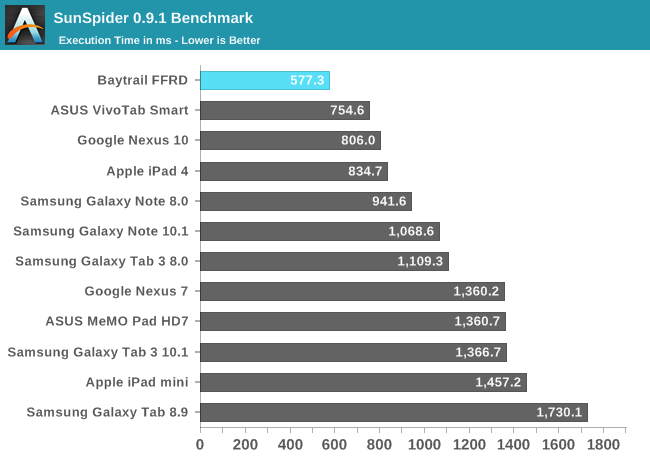
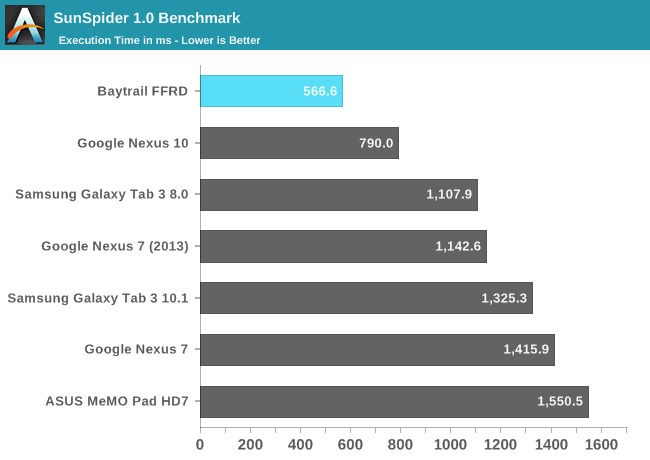
Sunspider has been a regular staple but in recent time has become an exercise in browser JavaScript engine optimization rather than actual performance. Nevertheless the FFRD takes the crown in both 1.0 and 0.9.1 (we have more tablet data from the 0.9.1 version so I replicated it here).
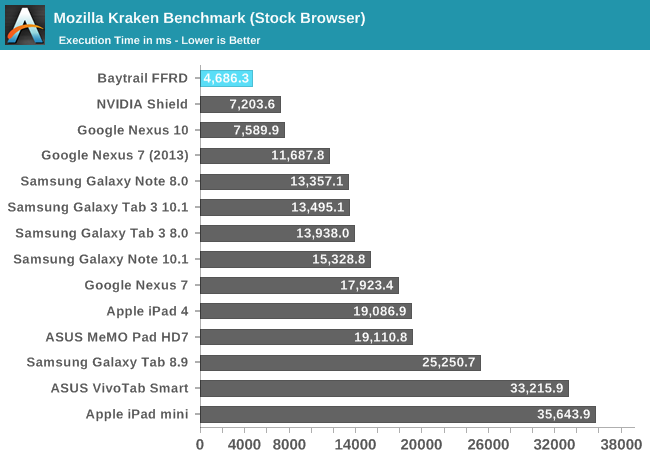
Kraken is another JavaScript benchmark which hasn’t quite been an optimization target everyone has gone after lately, and it’s also longer, which makes it a bit more reliable. Once again Bay Trail takes the crown here with notably faster JS engine performance.
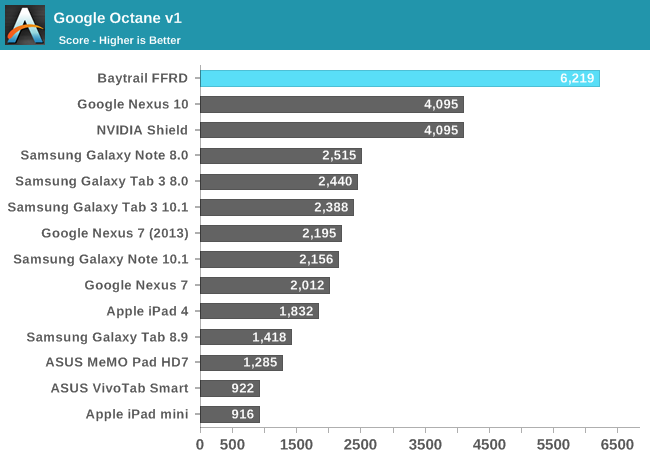
Google Octane is another JS test that isn’t quite as platform optimized yet, here there’s once again dominance by Bay Trail with just over a 50 percent higher score.
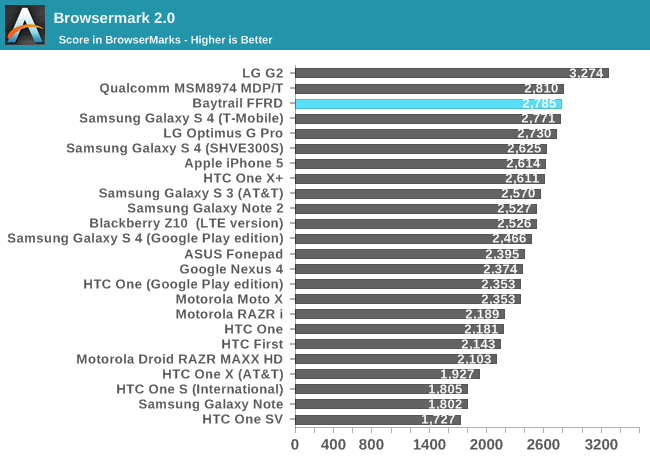
Browsermark has a combination of both JS tests and other web related performance metrics. Here the Bay Trail platform lags behind the 8974 based devices slightly. This isn’t a raw JavaScript benchmark again but rather a more holistic web browsing performance test, so it’s interesting to see Bay Trail a bit behind here.
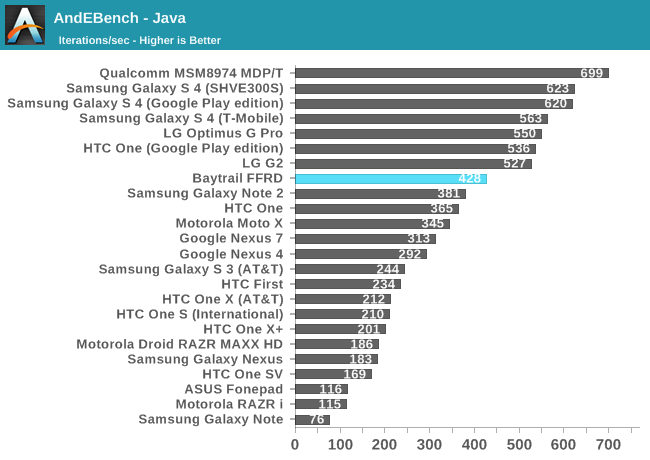

AndEBench is a combination native compiled microkernel benchmark (indicative of NDK application performance) that also runs a very similar workload atop Dalvik like a normal Android Java application. Here we can see what Intel was talking about when they said they have more work to do getting Dalvik working properly at dispatching threads to appropriate cores, hopefully the Java number will climb considerably. The native test also shows a lead over the competition.
GPU Performance
While Bay Trail clearly leads on the CPU side, its GPU performance is more middle of the road - at least among the higher end SoCs. In 3DMark Bay Trail's GPU performance is aided by the more CPU bound nature of the benchmark, but here Intel is able to beat the Snapdragon 600. Snapdragon 800 on the other hand pulls ahead by around 35%.
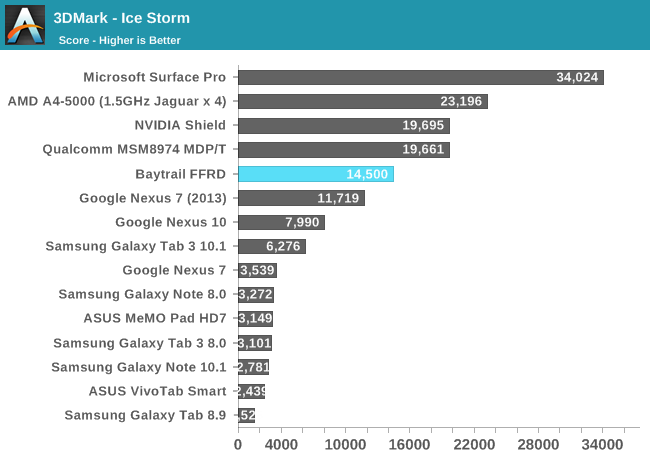
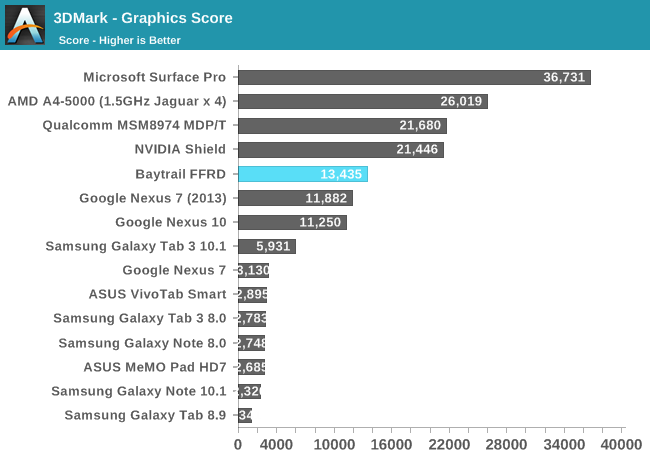
The 3DMark Physics test is effectively a CPU test, which once again plays to Bay Trail's strengths. Here it's faster than Snapdragon 800 and Cortex A15. Only Ivy Bridge is quicker in a tablet.
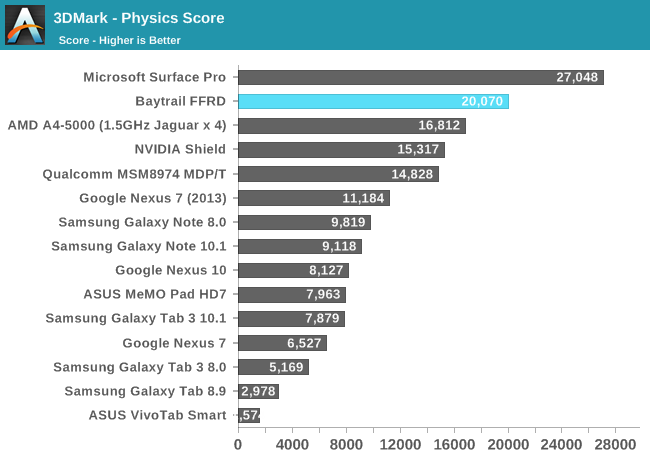
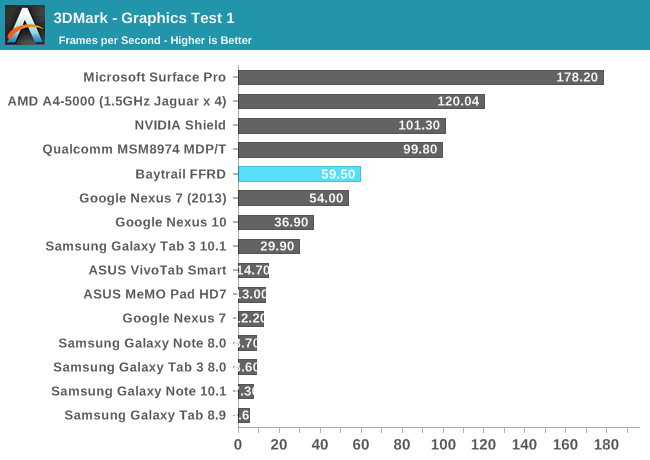
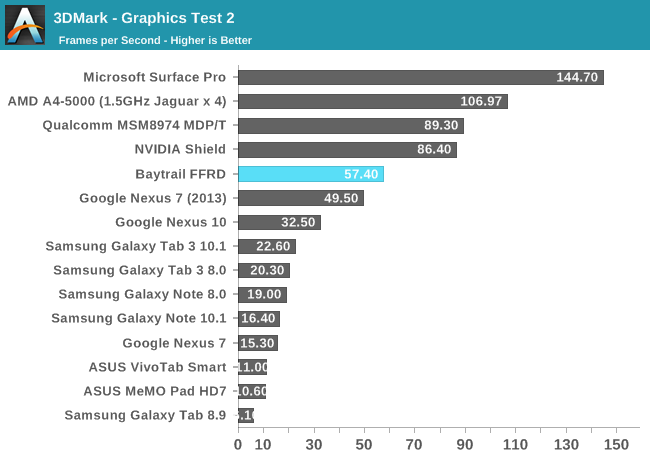
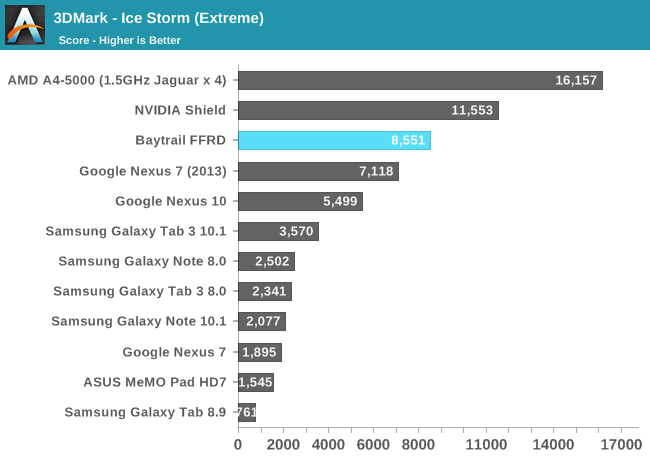
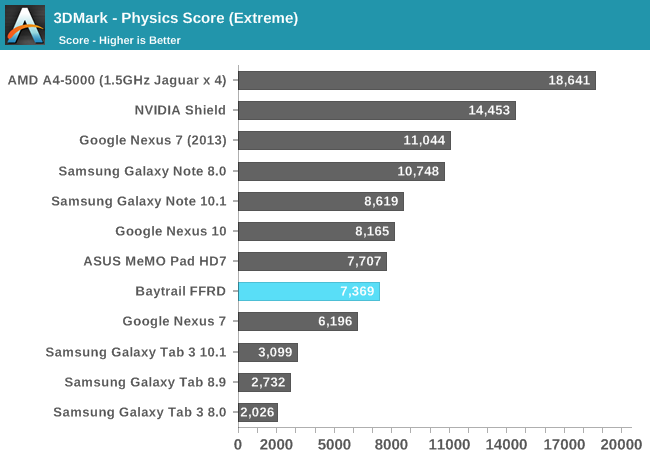
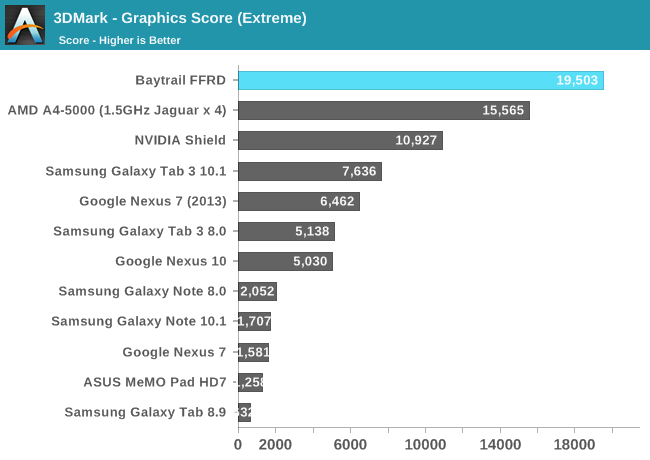
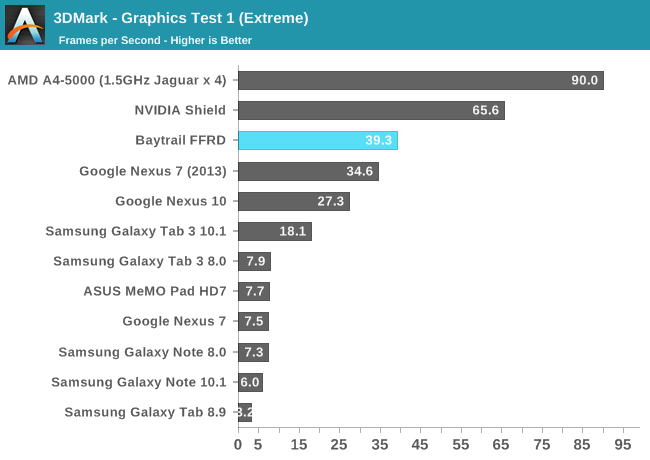
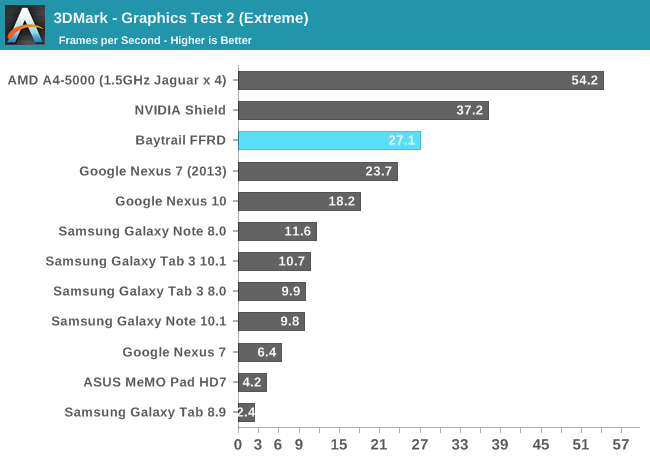
Basemark X
Basemark X is a bit more GPU bound than 3DMark, and we also have iOS data here so we can put Bay Trail's performance in better perspective. Here Bay Trail is a bit slower than the iPad 4, and clearly Tegra 4 and Snapdragon 800. Intel's GPU in Android is measurably quicker than Adreno 320/S600 though.
Bay Trail's onscreen performance is penalized by the FFRD's extremely high native resolution.

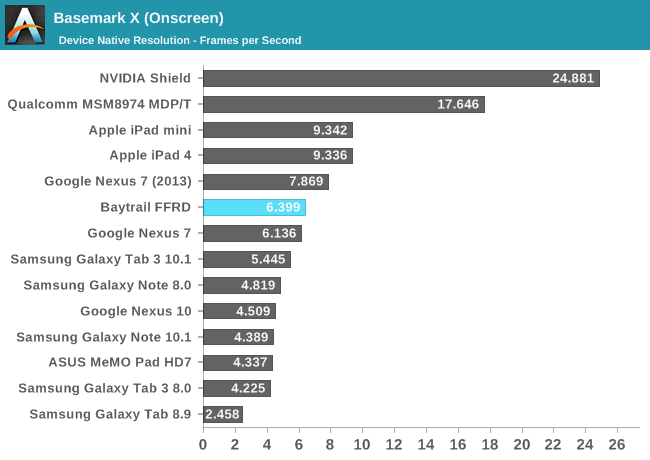
GLBenchmark 2.7
The more interested GLBenchmark numbers, T-Rex HD, show Bay Trail just behind the iPad 4 in performance. It's definitely not bad at all but clearly not industry leading.
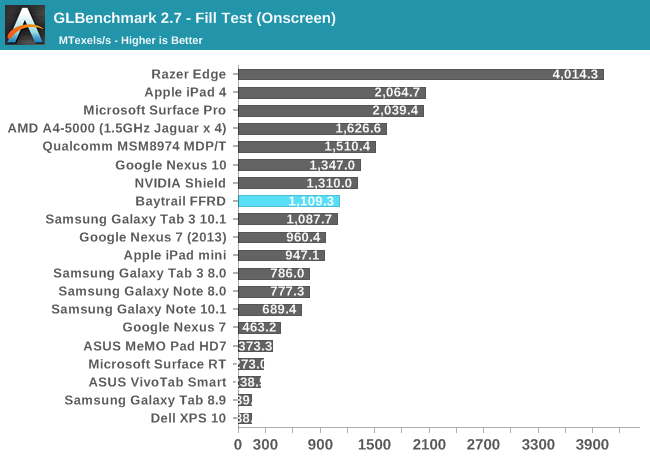
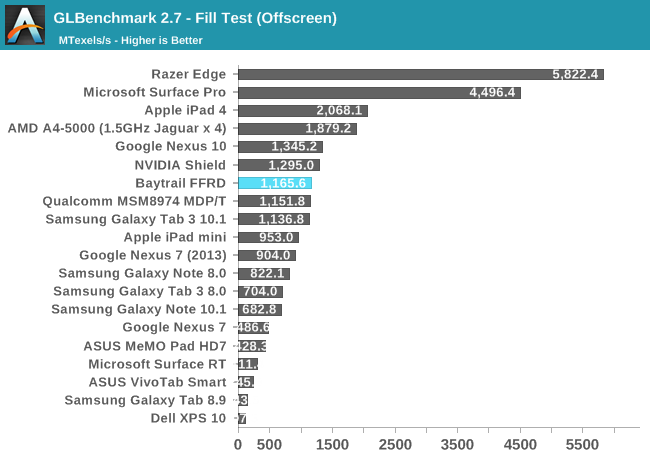
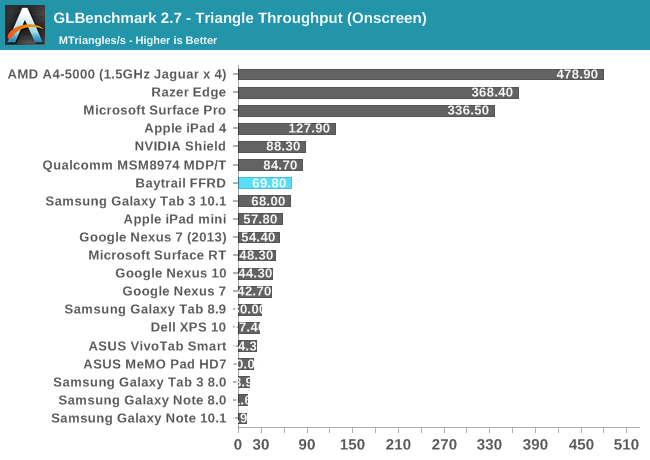
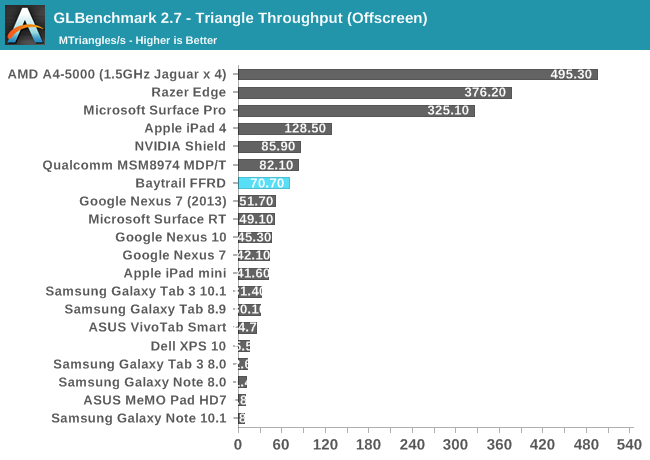
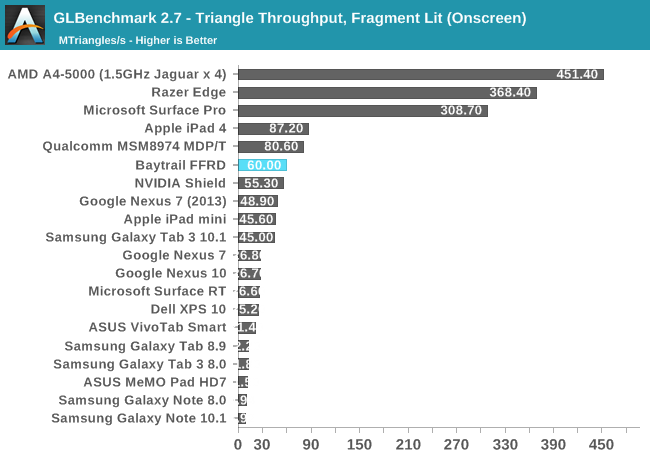
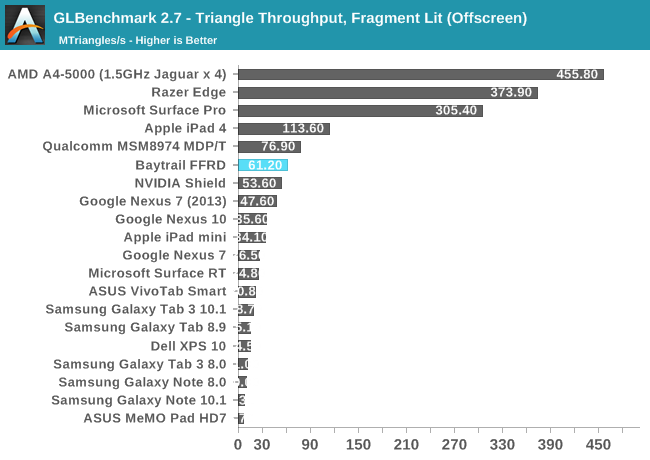
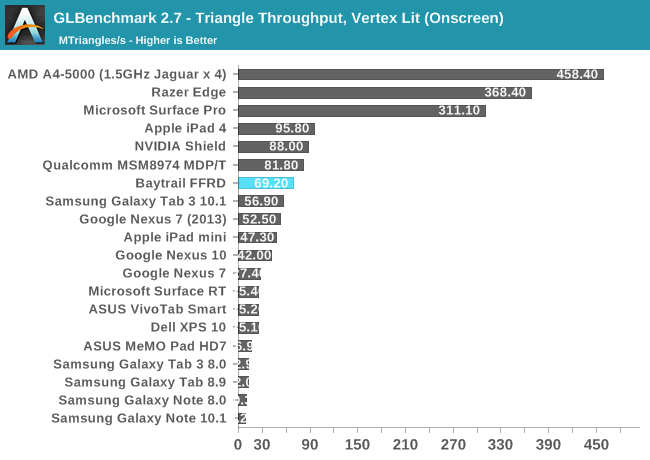
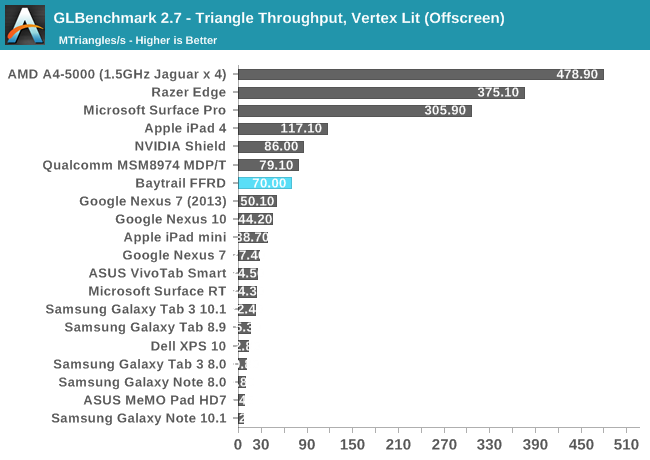
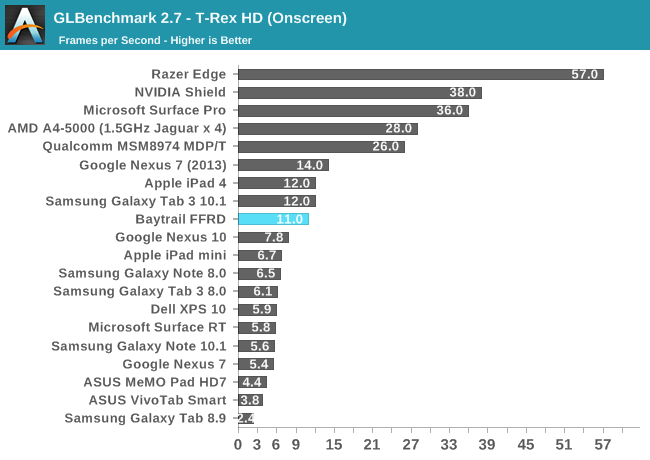
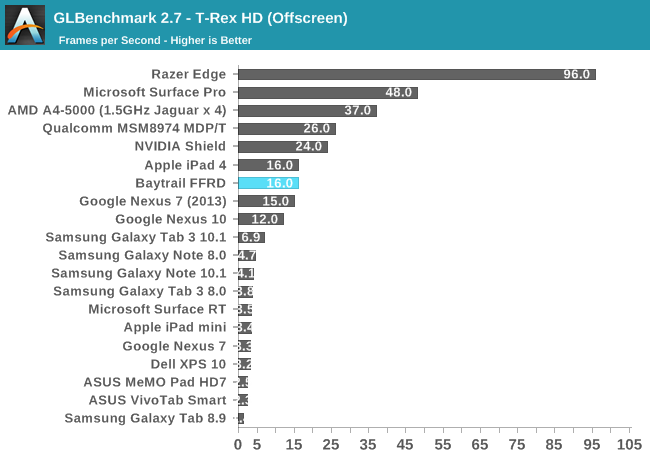
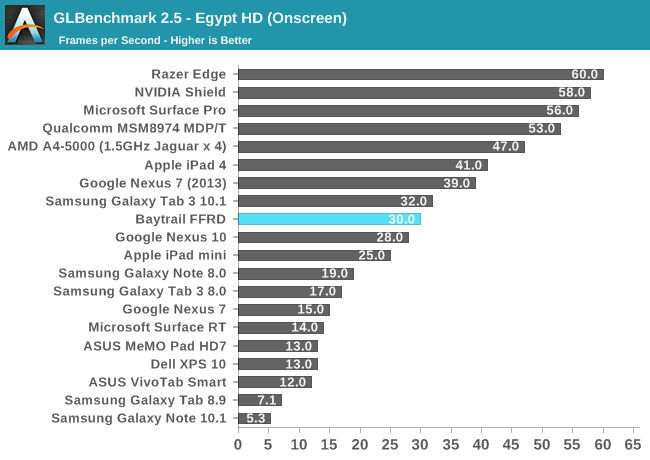
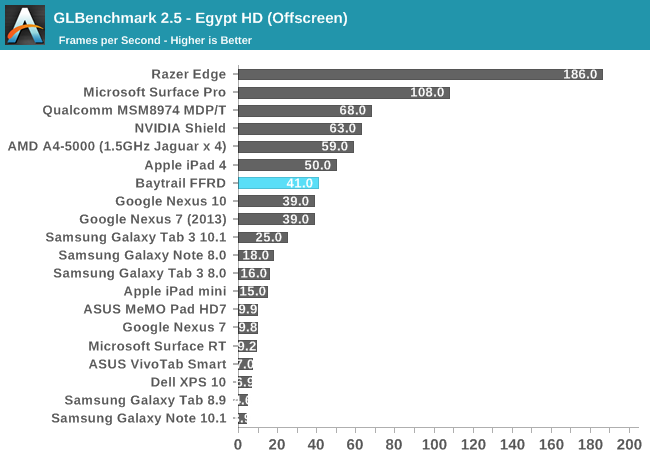
















190 Comments
View All Comments
drothgery - Friday, September 13, 2013 - link
Some Silvermont-core based chips will have Pentium or Celeron branding, FWIW.phoenix_rizzen - Monday, September 16, 2013 - link
Yeah, because "Celeron" is so much better when it comes to the "everyone knows it's horrible" viewpoint. And "Pentium" has become so overloaded as to be meaningless.To be honest, Intel needs to just eliminate the Atom, Celeron, and Pentium brands, and add a new Core i1 series to replace it.
NotaFanBoy - Wednesday, September 25, 2013 - link
+1hakime - Thursday, September 12, 2013 - link
"Intel’s HD graphics in Bay Trail appear to be similar in performance to the PowerVR SGX 554MP4 in the iPad 4."It's really a bold affirmation given that from your own numbers the Bay trail is significantly slower than the PowerVR SGX 554MP4 in all but one test.
HisDivineOrder - Thursday, September 12, 2013 - link
I think Intel needs to make a big, big push to get a Bay Trail chip into a Google Nexus product of some kind (possibly to let Google iterate on the OS a bit with regards to x86 CPU's), which was the original reason for Nexus btw.I also think Intel needs to convince MS with extremely low cost chips to make a Surface with Windows 8 and Bay Trail. Just dump Surface based on RT or knock it down to rock bottom pricing. Like $99 for Surface RT, $199 for Surface Pro Bay Trail, $499 for Surface Pro I3, $699 for Surface Pro I5, and $999 for Surface Pro I7 with Iris 5200.
That's if they insist on keeping RT around rather than just fold its development into Windows Phone, merge the two, and quietly take RT as a tablet OS around back behind the shed where the sun is just coming up over the trees, where the wind is blowing a little, and MS tells RT for tablets to look out through the trees.
Birds would start and fly away suddenly as a gunshot echoes.
Sad, but knowing it was for the best, MS could take the remains of RT to frankenstein-stitch into Windows Phone. It's not like it'd be the first time they rebooted a phone OS AND not the first time they stitched unrelated things together into a new product.
dwade123 - Thursday, September 12, 2013 - link
GPU is still Intel's Achilles Heel.Hrel - Thursday, September 12, 2013 - link
Seems they are weakest in GPU, as usual. I'd like to know why in one test they get clobbered by the Nvidia shield for Physics but then in another physics test the clobber Nvidia. Same thing happens with graphics. You'd think they'd be consistently better/worse at one or the other.With Nvidia releasing their first "real" mobile GPU soon (Q2 2014 I believe) Intel is going to have to at least double GPU performance in under a year to stay competitive. I doubt they can do that.
With that said, I really hope 3rd party OEM's starting using Bay Trail's CPU but packaging an Nvidia GPU.
It really is too bad Intel and Nvidia had that falling out over who buys who and is worth what and all that. If they were working together, the best CPU engineers with the best GPU engineers, just think what could have been.
nofumble62 - Thursday, September 12, 2013 - link
"With Nvidia releasing their first "real" mobile GPU soon (Q2 2014 I believe) Intel is going to have to at least double GPU performance in under a year to stay competitive. I doubt they can do that"I thought they have tripled the graphic performance of CloverTrail.
snarfbot - Thursday, September 12, 2013 - link
would it be possible in the future to put each devices soc in parenthesis or something in the charts, ideally with nominal frequencies, core count etc. that way it would be possible to evaluate comparable products from other manufacturers that you didnt directly review.like shield (tegra 4, a15 quad/1.9ghz, 72core/??mhz..) something like that. also even though this is a tablet review they still use largely the same hardware as smartphones, so it would make comparing actual hardware alot easier. even considering something like the moto x, with the frequency information next to the cores its performance would make sense relative to the rest of the products on the graph.
as it is now, you cant really draw any conclusions unless you cross reference the items listed with their specs on wikipedia or even worse random android forums.
so please please please, more info please.
sanketh - Friday, September 13, 2013 - link
I am just curious, Why does anand tech use the base frequency when intel is advertising its baytrail with the boosted frequency? Is the boost disabled? Can you provide system configurations for the Windows 8.1 benchmarking?